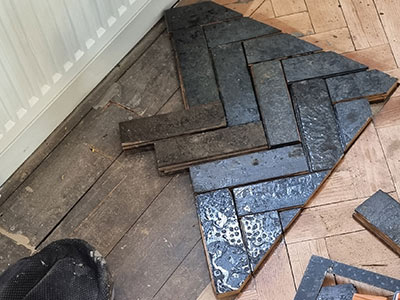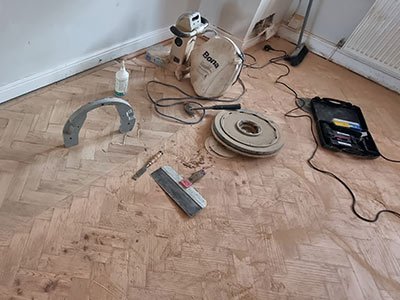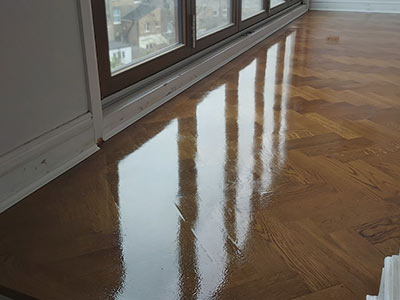Back to Parquet Restoration
DIY Parquet Floor Restoration
Parquet floors are a timeless classic that can add elegance and charm to any home. Unfortunately, as with any floor, regular maintenance and care are required to keep them looking their best. DIYers who want to restore their parquet floors need to have the right tools, techniques, and products in order to get the best results.
Preparing Your Parquet Floors for Restoration
 Preparing your parquet floors for restoration begins with cleaning and inspection. Before you begin any restoration work, you should vacuum your floor to remove dust and dirt particles that can scratch up the surface if not properly removed. If there is any gunk or sticky residue left on the floors that cannot be removed with a vacuum, use an appropriate cleaner such as a mild soap solution or pH-neutral cleaner and damp mop to cleanse the floors before proceeding further. Next, inspect the wood for signs of damage like cracking, warping, or unevenness.
Preparing your parquet floors for restoration begins with cleaning and inspection. Before you begin any restoration work, you should vacuum your floor to remove dust and dirt particles that can scratch up the surface if not properly removed. If there is any gunk or sticky residue left on the floors that cannot be removed with a vacuum, use an appropriate cleaner such as a mild soap solution or pH-neutral cleaner and damp mop to cleanse the floors before proceeding further. Next, inspect the wood for signs of damage like cracking, warping, or unevenness.
If these issues are present, determine what type of repair process will be required in order to restore the floor’s original condition prior to continuing with any other restoration tasks. Also, go around looking for loose tiles or planks and make sure all joints are secure so they don’t pull apart later on. Lastly, check for discolourations or fading due to sunlight exposure and/or chemicals that may have been used previously - these need to be addressed as they can affect the overall outcome of the restoration project. With careful cleaning and inspection, you can ensure that your parquet floor is prepared correctly for long-term future success!
Repairing Damaged Areas of Parquet Floors
 Repairing damaged areas of parquet floors can be a challenging task for DIYers. The trick is to find replacement pieces that match the existing floor perfectly. It is important to note that even if you do find a matching piece, it may not fit perfectly due to years of wear and tear on the existing flooring. To ensure that the new piece matches up with the old flooring as closely as possible, it is best to sand down both pieces until they are flush and smooth against one another.
Repairing damaged areas of parquet floors can be a challenging task for DIYers. The trick is to find replacement pieces that match the existing floor perfectly. It is important to note that even if you do find a matching piece, it may not fit perfectly due to years of wear and tear on the existing flooring. To ensure that the new piece matches up with the old flooring as closely as possible, it is best to sand down both pieces until they are flush and smooth against one another.
Additionally, use wood putty or another type of filler compound to fill any gaps before sanding and staining the surface. To prevent future damage from happening, consider applying a sealant or wax over the entire floor once repairs are made. Always make sure that when repairing parquet floors you use materials and tools specifically designed for parquet so that your repairs look natural and last longer.
Choosing the Right Equipment, Tools, and Materials
When restoring parquet floors, it is essential to select the right tools and materials for the job. DIYers should first assess the type of flooring they are dealing with and consider the appropriate tools accordingly. For instance, a sandpaper disc sander or belt sander might be used for larger projects, while detail sanders and orbital sanders could be used for smaller areas. It is advised to use fine-grade paper that does not leave deep scratches in the wood. When applying a finish, such as oil or wax, DIYers need to select high-quality products which will last long without damaging the flooring.
A roller is also recommended as it helps spread out any excess product evenly and quickly. Additionally, when using a vacuum cleaner to remove dust during the preparation stages, one should ensure that it has a soft brush attachment so that it does not scratch or damage the surface of the parquet flooring in any way. When working on large-scale projects, one should ensure that there are plenty of drop cloths available in order to protect all surrounding surfaces from any dust particles that may arise during restoration work.
Applying Top Coats, Waxes and Sealers
 Applying a top coat, wax or sealer to your parquet floors is an important step for any DIYer looking to restore their floors. Selecting the right product for your type of flooring is essential – different products work best depending on the material and finish of your floor. After preparing the surface of the floor and allowing it to dry, applying a top coat can help protect against scratches, enhance the natural beauty of your floor, and prevent dirt and dust from accumulating in the wood grain. When selecting a top coat product, look for one that offers extra protection against water damage as well as UV exposure.
Applying a top coat, wax or sealer to your parquet floors is an important step for any DIYer looking to restore their floors. Selecting the right product for your type of flooring is essential – different products work best depending on the material and finish of your floor. After preparing the surface of the floor and allowing it to dry, applying a top coat can help protect against scratches, enhance the natural beauty of your floor, and prevent dirt and dust from accumulating in the wood grain. When selecting a top coat product, look for one that offers extra protection against water damage as well as UV exposure.
Waxing or sealing your parquet floors will provide added coverage while also giving them an attractive glossy finish. For waxes, opt for those reinforced with polyurethane or acrylic resins, as they tend to last longer than traditional waxes. As you apply the wax, ensure that it won’t become too slippery when wet by using several thin coats instead of one thick layer – this will allow time in between coats so that each application is clear and level before adding another layer. When applying sealers, select one that is specifically designed for use on parquet floors for maximum protection and ease of maintenance. Although it may require more elbow grease than other methods of restoration, applying these top coats, waxes and sealers are sure to give your parquet floors a beautiful new look that lasts for years to come!
Cleaning, Polishing, and Protecting
When it comes to cleaning, polishing, and protecting your parquet floors, there are a few things to keep in mind. Always start with a clean floor. Any dirt or debris on the surface will just get in the way of the polishing process. Be sure to use a high-quality polish designed specifically for parquet floors. This will help ensure a smooth, even finish. Finally, protect your floors by applying a topcoat of wax or sealant. This will help repel dirt and stains and keep your floors looking like new for longer.